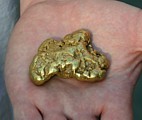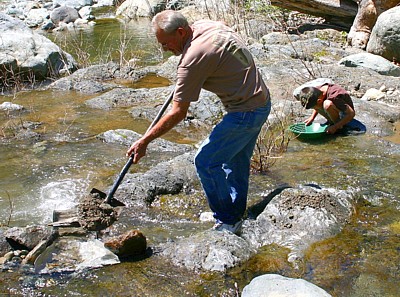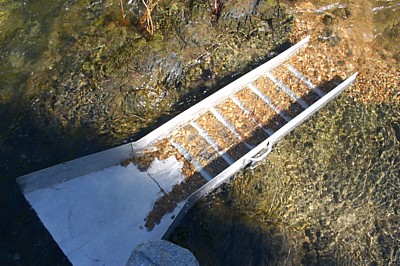Using A Sluice Box to Find Gold

.

|
Using A Sluice Box to Find Gold |
 |
||
|
. |
Interested in using a simple sluice box to find gold? This is my page of information on placer mining for gold with a sluice. A sluice is a very popular device and is often the second piece of gold prospecting equipment purchased by the new prospector (it was for me). You can process a good amount of gravel using a sluice, so learning how to use one is very worthwhile. If you work hard your sluice will really capture the gold and producing a nice placer gold product. Take a look at the following information....... |
 |
|
|
A sluice box lined with riffles is one of the oldest forms of gravity separation devices still used today. They are simple and have been in use all across the world for thousands of years. The size of a sluice can range from small, portable aluminum models used for prospecting all the way up to large units hundreds of feet long, as are used in commercial operations. Sluice boxes can be made out of wood, aluminum, plastic or steel. A sluice is really nothing more than an artificial channel lined with devices to catch gold through which water flows moving the lighter materials such as clay, sands and gravels out of the sluice. The heavier materials remain behind, trapped by the riffles. The huge advantage that the early prospectors found in sluice boxes was that they could process the gold bearing gravels much faster. An experienced panner might be able to work one cubic yard of gravel per day, but he could run a cubic yard of gravel in less than an hour through a sluice box. This allowed the miner to produce a lot more gold, and it still does the same for us today. Modern sluices are often built as one unit although sluices formed in sections are still used especially for larger commercial systems. Sluice boxes designed for individual prospectors are small and light, designed for maximum portability. As a rule, a long narrow sluice is more efficient than a short wide one. The sluice should have a slight slope, usually in the range of about 1/2 to 2 inches per foot, depending on the amount of available water, the size of material processed, and the size of gold particles. Larger flows of water and steeper slopes are required to move larger rocks out of the sluice box. Unfortunately, steep slopes and large flows of water also result in poor recovery of fine gold. |
|
|
|
The riffles in a sluice retard the material flowing in the water, and form a sand bed which also traps heavy particles and creates turbulence. This turbulence causes heavy particles to tumble, and helps flush lighter material out of the box. An overhanging lip on each riffle, known as a Hungarian style riffle, increases the turbulence, and forms a small eddy zone behind the riffle, helping to trap fine gold. Spaghetti weave mats, as well as some types of carpet, screens, and other liners are also used today to cover the bottom surface of the sluice, helping further to trap the fine gold. The sluice box is not hard to operate - it is forgiving of the surges of gravel that comes in with each shovel full we add. To perform efficiently, a sluice needs a good amount of water. Just enough water should be going in with the feed gravels to move the material out of the sluice in a reasonable time, allowing only the heavier materials to build up behind the riffles. The riffles should not become fully buried, nor should the entire bed of the sluice a blanketed over with gravel. For maximum recovery, the flow should be turbulent, yet not frothy in any way. Excessive turbulence results in poor fine gold recovery. |
 |
|
|
Riffles can be made of wood, rocks, rubber, iron or steel, and while historically wood or rock were common, wood is not durable and rock is too heavy and cannot be formed to specific shapes easily. Most riffle systems today are made from some form of mild steel. Riffles range from one half to about 2 inches high depending on the size of rock being processed through the sluice, larger riffles being used with larger rock. Generally, each riffle is placed several inches apart, one after the other. A set of riffles is commonly fastened to a rack that is wedged or bolted onto the sluice so that they can be easily removed for recovering the concentrates when the sluice is to be cleaned out. For cleanup, clear water is run through the sluice until the riffles are clear of excess gravel. A container is placed at the discharge end to prevent loss of concentrate. Starting from the head of the sluice, riffles are removed and carefully washed into the sluice. Any matt or bottom liner is removed and washed as well. Any large pieces of gold should be removed by hand during the sluice cleaning process as the concentrate is being washed out of the sluice into a suitable container. The collected concentrate is further processed by panning, tabling, or a variety of other methods. After cleanup, the sluice is reassembled and is once again ready for more material to be processed. Gold recovery with sluices can vary depending on a number of factors. To a certain extent, fine gold losses can be minimized by cleaning up more frequently, but excessive cleanup results in loss of time processing new material. It is better to examine the operating factors such as the flow of water, the slope pitch of the sluice, the size of the gravel feed, and the riffles and liners being used in the sluice. The addition of a liner to the bottom of the sluice helps quite a bit to trap fine gold. |
||
|
Overall, sluices are widely used today due to their low cost and ease of manufacture. They have many advantages. They require little supervision and maintenance; they can tolerate large fluctuations in feed volume; they are portable; properly operated, they can approach a gold recovery of 90%. They also require only a minimal initial investment. The biggest disadvantage is that very fine particles of gold are not effectively recovered. In addition, sluices can not operate when they are being cleaned which requires a certain amount of downtime. Fairly large volumes of wash water are also needed to operate them. They are available in various configurations as pre-made units from a variety of manufacturers. However many sluice boxes are simply fabricated by the user for specific operations, as their construction is not particularly difficult. I did up a web page on building your own sluice box - Take a look: Build Your Own Sluice Box |
 |
|
|
Over the years, a wide variety of variations to the standard sluice box have been developed. Here are a couple of old time varieties of sluice boxes. The terminology for the long tom and dip box are really no longer used. The Long tom. Among the many variants of the sluice, the old time long tom was the type used by the 49ers and other early day prospectors. It is actually a small sluice that uses less water than a regular sluice. It consists of a sloping trough about 12 feet long, 15 to 20 inches wide at the upper end, flaring to 24 to 30 inches at the lower end. The lower end of the box was set at a 45 degree angle and is covered with a perforated plate or screening. Below this screen a second long tom box was set up containing additional riffles; it was wider and usually shorter and set at a shallower slope than the first box. It was common to set these up in a long series of sluices were multiple operators to be shoveling in to the box a very points. The long tom uses much less water than a sluice but requires more labor. Material is fed into the upper box and then washed through, with water. An operator breaks up the material, removes boulders, and works material through the screen. Larger rocks were often removed and tossed aside using a pitchfork. Coarse gold settles in the upper box and finer gold in the lower. The capacity of a long tom is 3 to 6 yards per day. Other than using less water, advantages and disadvantages are the same as for other sluices. Dip-box. The dip-box is a another modification of the sluice that is used where water is scarce and the grade is too low for an ordinary sluice. It is a close cousin to the rocker box. It is simply a short sluice with a bottom of one by 12 inch lumber, with 6-inch-high sides and a 1 to 1-1/2 inch end piece. To catch gold, the bottom of the box is covered with burlap, canvas, carpet, Astro-Turf, spaghetti mat or other suitable materials. The box is set with the feed end about waist high and the discharge end 6 to 12 inches lower. Material is fed, a small bucketful at a time, into the back of the box. Water is poured gently over it from a dipper, bucket, or hose until the water and gravel are washed out over the lower end. The dipper box uses even less water than a long tom, but the finest sizes of gold are not effectively recovered. |
|
|
|
|
|
|
Want to know a little bit more about this crazy prospector guy? Well, here's a little bit more about me, and how I got into prospecting: Chris' Prospecting Story Interested in seeing more gold? Here are some interesting photos of beautiful Gold Nuggets